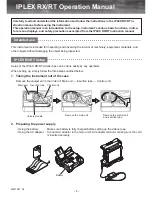
Chapter 12
599
RF Section
Low Band Problems
Low Band Problems
1. Disconnect all inputs from the front panel INPUT 50
Ω
connector.
2. Set the spectrum analyzer to the following settings:
Center frequency .......................................................... 0 Hz
Span .......................................................................... 1 MHz
Input attenuator ........................................................... 0 dB
3. The LO feedthrough amplitude observed on the display should be
between
−
6 (above top of screen) and
−
30 dBm.
NOTE
The marker will not PEAK SEARCH on the LO Feedthrough when in a
non-zero span. To measure the LO Feedthrough amplitude with the
markers, set the SPAN to 0 Hz and
CENTER FREQ
to 0 Hz. Press
MKR
ON.
4. If the LO feedthrough amplitude is within limits, but signals are low,
the RF path following the A8 mixer is probably operating properly.
5. If the LO feedthrough amplitude is higher than
−
5 dBm (signal will
be "clipped" at top of screen) and signals are low in amplitude,
suspect a defective A8 mixer assembly.
6. If signal amplitudes <2.9 GHz are bad, but signals >26.8 GHz are
good, check the A8 Low Band Mixer or the filter FL1. If both the LO
feedthrough and signal amplitudes are low, check the A12 SBTX.
7. Perform the steps located in
“Control Latch for Band-Switch
8. Check A13 second converter mixer diode bias at A14J19 pin 1. The
bias voltage should be between
−
150 and
−
800 mVdc.
9. Troubleshoot the signal path. Refer to the power levels listed on
, RF Section Troubleshooting Block
Diagram.
Summary of Contents for 8564EC
Page 17: ...25 1 General Information ...
Page 37: ...47 2 Adjustment Diagnostic Software ...
Page 77: ...89 3 Manual Adjustment Procedures ...
Page 129: ...161 3a Manual Adjustment Procedures 3335A Source not Available ...
Page 142: ...175 4 Assembly Replacement ...
Page 194: ...Chapter 4 257 Assembly Replacement Procedure 13 A21 OCXO Figure 4 34 A21 OCXO Mounting Screws ...
Page 196: ...259 5 Replaceable Parts ...
Page 218: ......
Page 219: ......
Page 220: ......
Page 221: ......
Page 222: ......
Page 223: ......
Page 224: ...303 6 Major Assembly and Cable Locations ...
Page 234: ...315 7 General Troubleshooting ...
Page 238: ...Chapter 7 319 General Troubleshooting Introduction Figure 7 2 Ribbon Cable Connections 1 of 3 ...
Page 239: ...320 Chapter7 General Troubleshooting Introduction Figure 7 3 Ribbon Cable Connections 2 of 3 ...
Page 242: ...Chapter 7 323 General Troubleshooting Introduction Figure 7 5 Service Cal Data Menu ...
Page 271: ...352 Chapter7 General Troubleshooting Block Diagram Description Figure 7 6 Functional Sections ...
Page 283: ...364 Chapter7 General Troubleshooting Block Diagram Description ...
Page 284: ......
Page 285: ......
Page 286: ......
Page 287: ...377 8 ADC Interface Section ...
Page 291: ...Chapter 8 381 ADC Interface Section Introduction Figure 8 2 A3 Test Connector Pin Locations ...
Page 321: ......
Page 322: ...427 9 IF Section ...
Page 356: ...Chapter 9 461 IF Section A5 IF Assembly Figure 9 13 Detailed IF Adjust Signature 5 ...
Page 376: ......
Page 377: ......
Page 378: ......
Page 379: ...487 10 Controller Section ...
Page 394: ...521 11 Synthesizer Section ...
Page 451: ......
Page 452: ......
Page 453: ......
Page 454: ...593 12 RF Section ...
Page 489: ...628 Chapter12 RF Section A15 RF Assembly Figure 12 10 10 MHz TTL Reference at U304 Pin 13 ...
Page 491: ......
Page 492: ...633 13 Display Power Supply Section ...
Page 504: ......
Page 505: ...671 14 Component Level Information Packets ...
Page 507: ......
















































